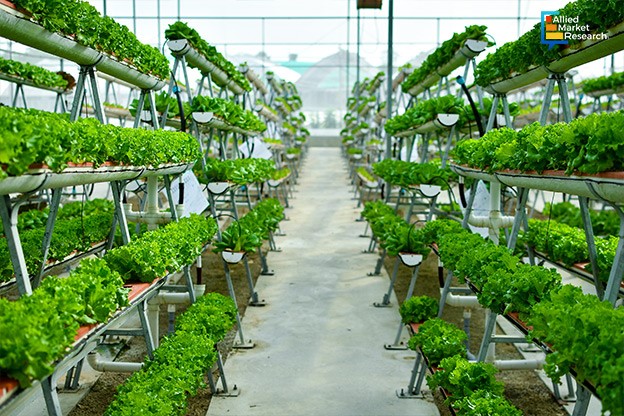Exploring the Reasons Why Vertical Farming is Deemed to be the Future of Agriculture?

15 Mar
2024
Highlights:
- Introduction
- Advantages of vertical farming over traditional farming
- The rise of the industry in Asia-Pacific region
As the global population keeps on increasing with each passing year, the demand for food is sure to rise. As a result, the emphasis on intensive agriculture has grown tremendously. However, despite technological advancements in farming equipment and the development of new varieties of seeds and fertilizers, global agricultural output has not increased by much. This is primarily because the land under cultivation hasn’t increased and it being a limited resource is not expected to increase in the coming period. Moreover, due to anthropogenic reasons, the problem of land desertification has become quite grave. In such a scenario, vertical farming has offered the perfect solution to increased agricultural productivity without any increase in pressure on land resources.
Why do experts consider vertical farming as the future of agriculture?
Vertical farming refers to a cultivation method where crops are grown on vertically stacked layers instead of a single horizontal layer like a regular field or greenhouse. Mostly, these layers on which cultivation takes place are stacked in a building or a warehouse. Hence, vertical farming is sometimes referred to as indoor farming. The vertical farming industry is expected to grow handsomely in the coming period due to some advantages offered by this new method of food cultivation.
The biggest advantage of vertical farming is that it makes efficient use of space. As opposed to traditional farming which requires multiple acres of land for productive farming, indoor farming can be done in a small space as the land required is distributed vertically. Thus, indoor farming maximizes food production per acre, thereby tackling the problem of land shortage. Furthermore, agriculture has always been thought of as a rural occupation since vacant fertile land is available mostly in the countryside. Contrary to this belief, indoor farming offers a way to pursue agricultural activities even in urban spaces by ensuring that all the requirements for food production are met.
An important characteristic of indoor farming is that the environment and climatic conditions can be controlled manually using temperature sensors and other technologies. As a result, indoor farming is independent of climatic conditions outside the room or warehouse. Hence, crops grown using indoor farming techniques are protected from adverse weather conditions like hailstorms, floods, droughts, etc. Furthermore, seasonal crops can now, using indoor farming methodologies, be grown all year round. Thus, indoor farming enables farmers to engage in year-round food production activities.
In the past few decades or so, agriculture has witnessed the introduction of several automation technologies that increase food productivity. Agricultural studies have shown that automation technologies are better suited to indoor farming as compared to traditional cultivation methods. Furthermore, the labor required for indoor farming is much less than that required for conventional farming. Thus, increased automation efficiency and reduction in labor help farmers save significant input costs, which ultimately makes farming profitable.
Indoor farming, in addition to other benefits, is environmentally sustainable as the amount of fertilizers, pesticides, and herbicides required is much less as compared to conventional farming techniques. Furthermore, indoor farming relies on hydroponics, i.e., the use of water-based nutrient solutions in place of soil for cultivation; indoor farming, thus, involves minimal use of water, and chances of soil erosion are also reduced.
Why is the Asia-Pacific region at the forefront of the adoption of indoor farming?
Among all major regions of the globe, the vertical farming sector is expected to witness huge growth in the Asia-Pacific region. This is primarily because many countries in this region still have agriculture contributing a substantial proportion to their national economy. Furthermore, due to a lack of proper mechanization in agricultural activities, traditional cultivation methods have proven to be unprofitable. Hence, farmers in these countries have been looking for alternative food production techniques and indoor farming has offered them a good solution. Among the various countries in this region, the industry in India is expected to rise at a stunning CAGR of 30.2% in the 2023-2032 period.
To conclude, indoor farming offers a viable and environmentally sustainable alternative to traditional farming. Fertile agricultural land being a limited resource has led to many farmers across the globe adopting this modern farming methodology. Moreover, since the input costs are reduced drastically, the profit margin in indoor farming is much higher as compared to conventional farming.
To get an in-depth analysis of the growth drivers and investment opportunities in the industry, feel free to contact us.

Akhilesh Prabhugaonkar
Author's Bio- Akhilesh Prabhugaonkar holds a bachelor’s degree in Electronics Engineering from the reputed Vishwakarma Institute of Technology. He has a special interest in the fields of forensics, world history, international relations and foreign policy, sports, agriculture, astronomy, security, and oceanography. An ardent bibliophile and melophile, Akhilesh loves to write on topics of his interest and various other societal issues. This love for writing made him enter the professional world of content writing and pursue his career in this direction.
Avenue: Entire Library membership of Allied Market Research Reports at your disposal
- Avenue is an innovative subscription-based online report database.
- Avail an online access to the entire library of syndicated reports on more than 2,000 niche industries and company profiles on more than 12,000 firms across 11 domains.
- A cost-effective model tailored for entrepreneurs, investors, and students & researchers at universities.
- Request customizations, suggest new reports, and avail analyst support as per your requirements.
- Get an access to the library of reports at any time from any device and anywhere.
Related Post
-
How are Submarine Cables Transforming Global Connectivity with Enhanced User Experience?
-
Endoscopy Procedures: Transformations in Techniques and Applications
-
AI-Powered Video Analytics: How the Product Actually Works for enterprises
-
Painting Robots: Transforming Precision Coating and Creative Applications
-
Innovations in Pharmacovigilance Systems Advancing Patient Safety
-
Understanding Edge Security: Keeping Data Safe Near the Source
-
Exploring the Use and Advancements of 3D Laser Scanners in Professional Applications
-
Reinforcing Industrial Controls with Smarter Tools and Training








